When life is challenging it can be helpful to read the signs nature gives us of rebirth and renewal. Trees, flowers, and shrubs put on new growth and in the bird world, spring brings us the annual miracle of migration to brighten our days and bring promise of new life. Today’s subjects, Turkey Vultures, wouldn’t win any beauty contest; in fact, they may better be considered candidates for the ugliest birds you are likely to see! But their return to our valley every spring is a sure sign that spring migration is well under way.
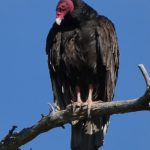
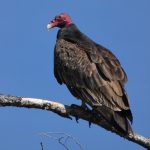 Turkey Vulture (adults). Click to enlarge.
Turkey Vulture (adults). Click to enlarge.
Turkey Vultures are big birds, just a little smaller than Bald Eagles, being 25–32”/64-81cm in length and with a wingspan of 5.5-6ft/1.7-1.8m. They have an all-dark body, two-town black under-wing, pink legs and a small red head bare of feathers. They live at least 17 years or more and widespread across North America, just coming up into southern Canada except the high mountains during the summer months. This year, 2020, I saw my first Turkey Vultures in late March, right on time.
Turkey Vultures gathered on a spit jutting into Okanagan Lake. Click to enlarge.
When you see them on the wing, they seldom flap but mostly soar with their wings held in a V-shape (dihedral), gently tipping from side to side. Social birds, they are often seen in flocks. Look for them foraging over mixed farmland and our partly forested or grassy hillsides, looking for anything dead on which to feed. This might be road killed deer, or other wild or domestic animals, or old animals brought down by coyotes, for example. At this time of year they also look for the afterbirth from farm cattle which have recently calved. They also take birds, reptiles, amphibians and fish. I have seen a large group of them at a creek mouth in late summer, presumably looking for dead or dying fish.
Turkey Vultures with their wings spread, on the ground and roosting. Click to enlarge.
Like cormorants, these birds often spread their wings wide, usually not to dry them but to sun themselves and increase their body temperature. You will often see them spreading their wings when they roost in trees. They nest in a variety of places such as on rocky ledges, dark recesses under stumps or large rocks, mammal burrows and hollow logs or even abandoned buildings. They raise one brood annually from a clutch of between one and three eggs.
How do they find their prey? Turkey Vultures have a keen sense of smell and can locate carrion from a surprisingly long distance away. And what about that bare head? Well, I don’t want to gross you out, but consider for a moment their food source. Feeding on a dead deer carcass, for example, requires the bird to stick its head into the animal’s rib cage or hind quarters, where blood and viscera will be unavoidable. Feathers on the vulture’s head would require constant and difficult cleaning, whereas bare skin is much easier to keep clean.
So as the days lengthen and spring shows itself in many ways, look up. You might see one or more of these large dark birds teetering above you. And as you drive around our lovely valley, watch for them roosting together on dead snags, sometimes with their wings outstretched. There is no surer sign of spring and renewal of life than spring migration.
Pam Laing, Okanagan birder







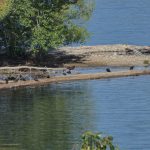
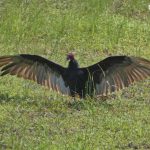
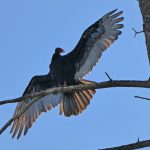
Nicole Kittmer
Love Pam’s posts, accounts, and pictures! Thank you Pam